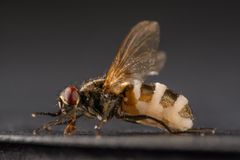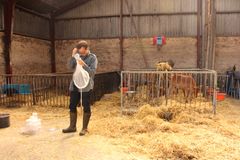New knowledge about a fungus that turns 60-80% of the flies in your home into zombies
How can a fungus take over a fly's behavior? An international group of researchers with participation from the University of Copenhagen hopes to find out with the help of a new genetic map of a unique fungus that transforms 60-80 percent of the flies in your home into zombies. In the future, the fungus could become both an effective insect repellent and basis for new psychotropic drugs.

What can we learn from a fungus that eats most of the flies in your home from the inside, turns them into zombies and then lures other flies to necrophilic intercourse? Possibly quite a lot, according to researchers at the University of Copenhagen.
Henrik De Fine Licht has been researching this very special fungus for years, a fly fungus – Entomophthora muscae – that takes over the behaviour of flies before killing them.
Most recently, he and a group of American research colleagues have succeeded in mapping the fungus’ genome, an achievement in itself because the massive genome is roughly 25 times larger than that of most other fungi. The goal is to find out how the fungus manipulates fly behavior.
"The genome is a catalogue of all the genes found in the fungus, which tells us something about the the organism’s capabilities. Such a catalogue can better equip us to look at which genes are active in a fly’s brain at the point when the fungus transforms it into this zombie-like state. And in this way, we hope to understand how it can do such a wild thing," says Associate Professor Henrik De Fine Licht of the University of Copenhagen’s Department of Plant and Environmental Sciences.
The new study has been published in the scientific journal eLife.
Makes fruit flies and houseflies necrophilic
Fly mold grows exclusively in flies. One subspecies of the fungus specializes in houseflies, while another uses fruit flies as hosts. The fruit fly-infecting subspecies was the one that the researchers sequenced the genome of in this study.
"Research has shown that up to 60-80 percent of the flies that fly around in a given room or cattle barn can be infected with this fungus. Zombie flies are typically found when one comes across a dead fly sitting on a window surrounded by a white ring of spores," says Henrik De Fine Licht.
Once the fungus has infected a fly, it eats the fly from the inside over the course of a week or so while the fly is alive. When nearly all of the fly’s nutrients have been consumed, the fungus starts to manipulate the brain and begins to take over the fly's behavior. It causes the fly to stick to a plant or window, as high up as possible.
"At this point, almost the entire body consists of fungal mass, and eventually all of the fly’s normal processes stop. Over the course of a few hours, the fungus begins to shoot fungal spores out of the hind of the fly's body. In the process, it also secretes chemical fragrances that attract healthy flies. Once close, they try to mate with the dead flies, which allows the spores to grow into the healthy fly and repeat the process," explains the researcher.
The genes provide new knowledge about the fungus' unique properties
While the fungal life cycle is well described, very little is known about how it all works. The new map of the fungus’ genome will probably be able to shed light on this.
In the new study, the group of researchers – which includes biologists from Harvard University – have discovered, among other things, that the fungus has a few unique genes which add perfect timing to the zombification equation:
"The behavioural manipulation always begins at dusk. We think this is adaptive for the fungus because humidity is higher at night, so it’s a better time to release infectious spores that are prone to drying out We now know that the fungus has genes that code for light-sensitive proteins. We suspect that, just like in other organisms, the fungus could be using light cues to tell the time. Thus, we believe that this is important clue in the mechanism underlying the timing of behavior manipulation," says last author Carolyn Elya of Harvard University.
Furthermore, the genome shows that the fungus has many copies of enzymes that are good at breaking down the hard chitin shells of insects.
"This reflects that the fungus has a unique evolutionary adaptation to grow and live in insects. While unsurprising, it has now been verified for the first time," says Elya.
Could be used for psychotropic drugs in the future
Even though this is fundamental research, Henrik De Fine Licht believes that there are several ways that humans could put the lessons of this fungus to good use in the future, should researchers be successful in revealing even more about its secrets:
"Understanding how the human brain works in relation to behaviour is often a challenge because it is difficult to measure precisely. But here, we have a system with a very defined behavior that we know is controlled by a fungus in the brain of an insect. If we understand how the fungus operates, we can begin to map the entire sequence from genes and molecules to behavior," says the researcher, continuing:
"And then, one may be inspired by the chemical substances and certain mechanisms that the fungus deploys to manipulate the fly's behaviour when, for example, designing new drugs for mental illnesses in humans."
In another sphere, there is the possibility of using the fly fungus for biological pest control. Because one of the disadvantages of both chemical pesticides and fungicides on the market today is that they attack many types of insects. Here, the fungus' specialized behavior can make a difference.
"Typically, you only want to target pests, while steering clear of honey bees and other beneficial insects. So, if further research leads to the development of an insecticide based on this fungus, which has the great advantage of only attacking one species of fly, it would be very, very attractive," concludes Henrik de Fine Licht.
ABOUT THE STUDY
- In addition to Henrik De Fine Licht and Carolyn Elya, the researchers behind the study are: Jason E. Stajich of the University of California-Riverside, United States; Brian Lovett of USDA-ARS, United States; Emily Lee and Benjamin L. de Bivort from Harvard University, United States, Ann E. Hajek from Cornell University, United States, and Angie M. Macias and Matt T. Kasson from West Virginia University, United States.
- The research article about the study has been published in the journal eLife.
Keywords
Contacts
Henrik De Fine Licht
Associate Professor
Department of Plant and Environmental Sciences
University of Copenhagen
hhdefinelicht@plen.ku.dk
+45 35 32 00 97 / +45 61 68 57 69
Maria Hornbek
Journalist
Faculty of Science
University of Copenhagen
maho@science.ku.dk
+45 22 95 42 83
Images
Links
ABOUT THE FACULTY OF SCIENCE
The Faculty of Science at the University of Copenhagen – or SCIENCE – is Denmark's largest science research and education institution.
The Faculty's most important task is to contribute to solving the major challenges facing the rapidly changing world with increased pressure on, among other things, natural resources and significant climate change, both nationally and globally.
Subscribe to releases from Københavns Universitet - Det Natur- og Biovidenskabelige Fakultet
Subscribe to all the latest releases from Københavns Universitet - Det Natur- og Biovidenskabelige Fakultet by registering your e-mail address below. You can unsubscribe at any time.
Latest releases from Københavns Universitet - Det Natur- og Biovidenskabelige Fakultet
Old aerial photos give scientists a new tool to predict sea level rise3.7.2025 08:00:00 CEST | Press release
Researchers from the University of Copenhagen have gained unique insight into the mechanisms behind the collapse of Antarctic ice shelves, which are crucial for sea level rise in the Northern Hemisphere. The discovery of old aerial photos has provided an unparalleled dataset that can improve predictions of sea level rise and how we should prioritise coastal protection and other forms of climate adaptation.
Gamle luftfotos giver forskere nyt redskab til at forudsige havstigninger3.7.2025 08:00:00 CEST | Pressemeddelelse
Forskere fra Københavns Universitet har fået unik adgang til at forstå mekanismerne bag antarktiske ishylders kollaps, som er afgørende for havstigninger på den nordlige halvkugle. Et fund af gamle luftfotos har skabt et enestående datasæt, som kan forbedre vores forudsigelser af hvor meget havene stiger, og vores prioritering af kystsikring og andre klimatilpasninger.
Ny institutleder på IFRO: ”Faglighed og fællesskab går hånd i hånd”1.7.2025 10:49:17 CEST | Pressemeddelelse
Per Svejstrup er fra 1. august ansat som institutleder på Institut for Fødevare- og Ressourceøkonomi (IFRO). Den kommende leder træder ind i rollen med stor respekt for IFRO's faglige og kollegiale kultur med klare ambitioner for fremtiden.
Dangerous Variant of Salmonella Still Not Eradicated – Researchers Point to the Solutions1.7.2025 09:53:23 CEST | Press release
The infectious and multi-resistant cattle disease Salmonella Dublin can be fatal to both humans and animals and causes significant losses for farmers. Although Denmark has attempted to eradicate the disease since 2008, it has not yet succeeded. A study from the University of Copenhagen points to possible reasons – and the necessary solutions.
Farlig type salmonella er stadig ikke nedkæmpet i Danmark – forskere peger på løsningerne30.6.2025 09:54:03 CEST | Pressemeddelelse
Den smitsomme og multiresistente kvægsygdom Salmonella Dublin kan være dødelig for både mennesker og dyr og medfører desuden betydelige tab for landmændene. Selvom Danmark har forsøgt at udrydde sygdommen siden 2008, er det ikke lykkedes. Et studie fra Københavns Universitet peger på den mulige årsag og de nødvendige løsninger.
In our pressroom you can read all our latest releases, find our press contacts, images, documents and other relevant information about us.
Visit our pressroom

